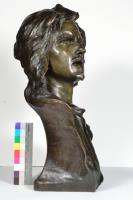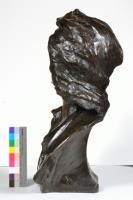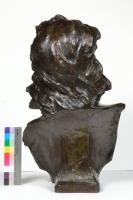Bust - Adam Dollard des Ormeaux
Quebec sculptor Alfred Laliberté created this bronze bust in 1923. It was cast by Roman Bronze Works, one of the first commercial foundries in America to master the lost-wax method and make sculptures equal in quality and complexity to those produced in Europe.
The subject is Adam Dollard des Ormeaux, a 17th-century French soldier and garrison commander at the Catholic colony of Ville-Marie on the Island of Montreal. In 1660, Dollard and several men under his command died fighting Haudenosaunee (Iroquois) opponents at the battle of Long Sault, some 100 kilometres west of present-day Montreal along the Ottawa River. Traditional accounts have emphasized Dollard’s heroism and sacrifice defending Ville-Marie, while historians over the years have raised questions about the circumstances leading to the battle at Long Sault.
The bust in Parliament’s collection is predated by Laliberté’s imposing bronze statue of Dollard in Montreal’s Lafontaine Park, which was inaugurated in 1920.


